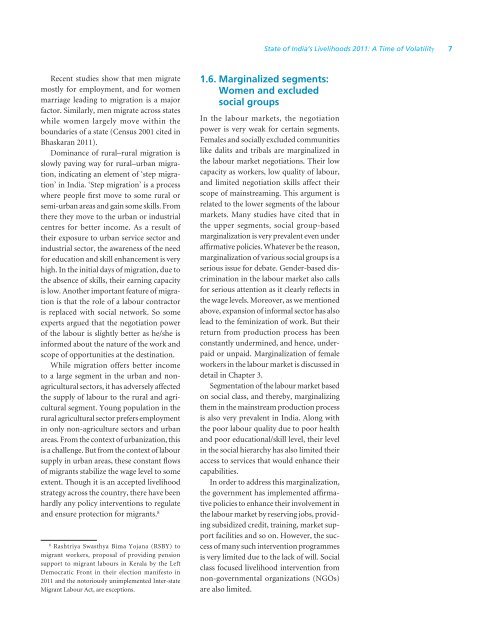SOIL Report 2011 - ACCESS Development Services
SOIL Report 2011 - ACCESS Development Services
SOIL Report 2011 - ACCESS Development Services
- No tags were found...
Create successful ePaper yourself
Turn your PDF publications into a flip-book with our unique Google optimized e-Paper software.
State of India’s Livelihoods <strong>2011</strong>: A Time of Volatility 7Recent studies show that men migratemostly for employment, and for womenmarriage leading to migration is a majorfactor. Similarly, men migrate across stateswhile women largely move within theboundaries of a state (Census 2001 cited inBhaskaran <strong>2011</strong>).Dominance of rural–rural migration isslowly paving way for rural–urban migration,indicating an element of ‘step migration’in India. ‘Step migration’ is a processwhere people first move to some rural orsemi-urban areas and gain some skills. Fromthere they move to the urban or industrialcentres for better income. As a result oftheir exposure to urban service sector andindustrial sector, the awareness of the needfor education and skill enhancement is veryhigh. In the initial days of migration, due tothe absence of skills, their earning capacityis low. Another important feature of migrationis that the role of a labour contractoris replaced with social network. So someexperts argued that the negotiation powerof the labour is slightly better as he/she isinformed about the nature of the work andscope of opportunities at the destination.While migration offers better incometo a large segment in the urban and nonagriculturalsectors, it has adversely affectedthe supply of labour to the rural and agriculturalsegment. Young population in therural agricultural sector prefers employmentin only non-agriculture sectors and urbanareas. From the context of urbanization, thisis a challenge. But from the context of laboursupply in urban areas, these constant flowsof migrants stabilize the wage level to someextent. Though it is an accepted livelihoodstrategy across the country, there have beenhardly any policy interventions to regulateand ensure protection for migrants. 88Rashtriya Swasthya Bima Yojana (RSBY) tomigrant workers, proposal of providing pensionsupport to migrant labours in Kerala by the LeftDemocratic Front in their election manifesto in<strong>2011</strong> and the notoriously unimplemented Inter-stateMigrant Labour Act, are exceptions.1.6. Marginalized segments:Women and excludedsocial groupsIn the labour markets, the negotiationpower is very weak for certain segments.Females and socially excluded communitieslike dalits and tribals are marginalized inthe labour market negotiations. Their lowcapacity as workers, low quality of labour,and limited negotiation skills affect theirscope of mainstreaming. This argument isrelated to the lower segments of the labourmarkets. Many studies have cited that inthe upper segments, social group-basedmarginalization is very prevalent even underaffirmative policies. Whatever be the reason,marginalization of various social groups is aserious issue for debate. Gender-based discriminationin the labour market also callsfor serious attention as it clearly reflects inthe wage levels. Moreover, as we mentionedabove, expansion of informal sector has alsolead to the feminization of work. But theirreturn from production process has beenconstantly undermined, and hence, underpaidor unpaid. Marginalization of femaleworkers in the labour market is discussed indetail in Chapter 3.Segmentation of the labour market basedon social class, and thereby, marginalizingthem in the mainstream production processis also very prevalent in India. Along withthe poor labour quality due to poor healthand poor educational/skill level, their levelin the social hierarchy has also limited theiraccess to services that would enhance theircapabilities.In order to address this marginalization,the government has implemented affirmativepolicies to enhance their involvement inthe labour market by reserving jobs, providingsubsidized credit, training, market supportfacilities and so on. However, the successof many such intervention programmesis very limited due to the lack of will. Socialclass focused livelihood intervention fromnon-governmental organizations (NGOs)are also limited.














